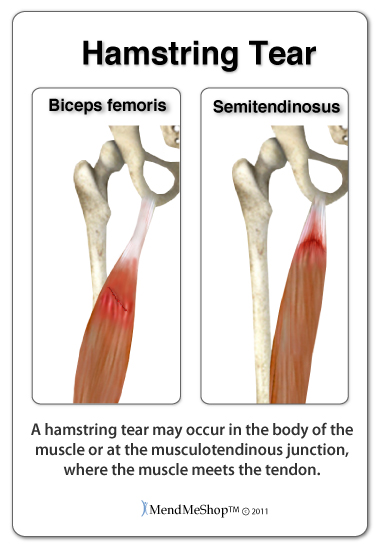A hamstring tear, also referred to as a grade II hamstring strain, occurs when the hamstring muscle, or tendon, fibers are excessively stretched and tear.

Your hamstrings are very long muscles that cross 2 joints (your hip and knee) therefore they are more prone to injury. A tear in the hamstrings can occur in the belly of one of the hamstring muscles (the biceps femoris, semitendinosus, or semimembranosus) or in the hamstring tendons that attach the 3 muscles to the ischium.
The biceps femoris muscle is the most frequently injured, as it suffers the largest stretch during sprinting, followed by the semitendinosus muscle. If you have a multi-muscle tear, it normally occurs at the point where your hamstring muscles and tendons meet, called the musculotendinous junction or musculotendinous complex. However, a tear can occur at any place along your hamstring muscle bellies, or at the tendon attachments to the bone.
Hamstring muscle tears occur most often early in the activity as a result of a poor warm up, or in the later stages of practices or games as a result of fatigue. Young, active teens or adults between 25-44 years are most susceptible to hamstrings strains and other hamstring injuries, and men are twice as likely to be injured as women.
If you have suffered from a forceful strain of the hamstring it is recommended that you see a doctor for a proper diagnosis as symptoms of a complete tear are similar to those of a hamstring pull or strain. Early diagnosis of a complete hamstring tear is very important. If treatment is delayed, a torn hamstring tendon may pull further away from the bone. This can result in a greater loss of power, the need for surgery, or a more serious condition in the lower back, buttock, calf, or posterior thigh.

Most hamstring injuries occur with a sudden forcible contraction of the muscles against resistence, when the muscle contracts while it is lengthened (an eccentric contraction). For example, when a water skier is pulled forward or a sprinter pushes off to propel forward.
The hamstrings are at greater risk of stretching or tearing if:

First and foremost, a hamstring strain should be given the rest it needs. You will need to take a break from the activity or sport that caused the strain until it has healed to prevent further injury. Treating your hamstring strain correctly is essential to getting rid of your pain and restoring function to your upper thigh. Proper treatment will get you back to regular activities sooner, stop your pain, and reduce the risk of future re-injury.
Within the first 72 hours of the tear (and longer if necessary)rest and elevate your hamstring, applying cold compression frequently to reduce pain and tissue damage. The cold will numb the area to reduce pain and compression will limit swelling and bleeding in the muscle.
To restore strength and range of motion in your hamstrings, treatment should focus on preventing scar tissue formation and muscle atrophy (shrinkage and weakening of the muscle). This requires rest and the appropriate therapies at the right time. Almost all types of hamstring pulls and tears (except a complete hamstring rupture which usually require surgery) can be properly treated with trusted therapies that are available for use at home.
AidYourHamstring advisors do not work on commission, so be assured you will only receive fair and objective information.
Product Advisors are available 9:00 am to 5:00 pm Eastern Standard Time Monday to Friday.
I want to learn more about Surgery & Post-Surgery Recovery
I want to learn more about Circulation Boost
I want to learn more about Ice & Heat: Which Is Better For Treatment?
I want to learn more about Stretching for the Hamstring
I want to learn more about Soft Tissue Injury Treatments
During your recovery, you will probably have to modify and/or eliminate any activities that cause pain or discomfort at the location of your soft tissue injury until the pain and inflammation settle. The more diligent you are with your treatment and rehabilitation, the faster you will see successful results!
Please be aware that this information is neither intended nor implied to be a substitute for professional medical advice. CALL YOUR HEALTHCARE PROVIDER IMMEDIATELY IF YOU THINK YOU MAY HAVE A MEDICAL EMERGENCY. Always seek the advice of your physician or other qualified health provider before using any of our outstanding products to make sure they are right for you and your condition or if you have any questions regarding a medical condition. Always see your doctor for a proper diagnosis as there are often many injuries and conditions (some very serious) that could be the cause of your pain.
© 2025 In.Genu Design Group, Inc. Contact Us